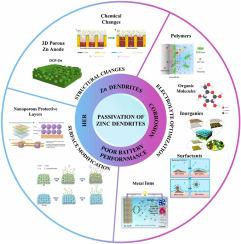Emerging strategies on structural and constitutional modifications of zinc anode for enhanced performance in aqueous zinc-ion batteries
IF 7.9
2区 工程技术
Q1 CHEMISTRY, PHYSICAL
引用次数: 0
Abstract
Aqueous zinc-ion batteries (ZIBs) are becoming increasingly popular as an efficient way to store energy due to their low cost, safety and environmental friendliness. Theoretical advantages of aqueous ZIBs are hindered to a large extent by Zn anode issues including dendrite formation and side reactions delaying its large-scale application. This review provides a comprehensive overview of the latest achievements and prospective advances in the development of anode material for the improved operation of aqueous ZIBs. The review begins with fundamental concepts behind aqueous ZIBs operation with the focus on key challenges that lead to anode deterioration and hence, overall poor performance. Recently, attempts have been made to improve the performance of aqueous ZIBs using various strategies. This study examines effective technological solutions in three main areas of aqueous ZIBs optimization: physical and chemical changes of Zinc anode interface modifications, and electrolyte optimization. There is a lack of thorough assessment of the physical changes of the anode, despite the fact that electrolyte additives and phase interface modifications have attracted a lot of attention and have been thoroughly studied recently. Therefore this article focuses on strategies and justifications for the anode structural modifications that have achieved excellent performance by suppressing dendrite formation and increasing battery efficiency, especially in terms of mechanisms of action. An overview of electrolyte additives and phase interface modifications is also provided.

提高锌离子电池性能的锌阳极结构和结构改性的新策略
水锌离子电池(zib)由于其低成本、安全和环保的优点,作为一种高效的储能方式正日益受到人们的欢迎。锌阳极的枝晶形成和副反应等问题阻碍了水相锌锌的理论优势,延缓了其大规模应用。本文综述了用于改进水基ZIBs操作的阳极材料的最新研究成果和发展前景。本文首先介绍了水溶液zib作业的基本概念,重点介绍了导致阳极恶化的关键挑战,从而导致整体性能不佳。最近,人们尝试使用各种策略来提高含水ZIBs的性能。本研究探讨了锌阳极优化的三个主要领域的有效技术解决方案:锌阳极界面修饰的物理和化学变化,以及电解质优化。尽管电解质添加剂和相界面修饰近年来引起了人们的广泛关注和深入研究,但对阳极的物理变化缺乏全面的评估。因此,本文将重点讨论通过抑制枝晶形成和提高电池效率,特别是在作用机制方面取得优异性能的阳极结构修改的策略和理由。还提供了电解质添加剂和相界面修改的概述。
本文章由计算机程序翻译,如有差异,请以英文原文为准。
求助全文
约1分钟内获得全文
求助全文
来源期刊

Journal of Power Sources
工程技术-电化学
CiteScore
16.40
自引率
6.50%
发文量
1249
审稿时长
36 days
期刊介绍:
The Journal of Power Sources is a publication catering to researchers and technologists interested in various aspects of the science, technology, and applications of electrochemical power sources. It covers original research and reviews on primary and secondary batteries, fuel cells, supercapacitors, and photo-electrochemical cells.
Topics considered include the research, development and applications of nanomaterials and novel componentry for these devices. Examples of applications of these electrochemical power sources include:
• Portable electronics
• Electric and Hybrid Electric Vehicles
• Uninterruptible Power Supply (UPS) systems
• Storage of renewable energy
• Satellites and deep space probes
• Boats and ships, drones and aircrafts
• Wearable energy storage systems
 求助内容:
求助内容: 应助结果提醒方式:
应助结果提醒方式:


